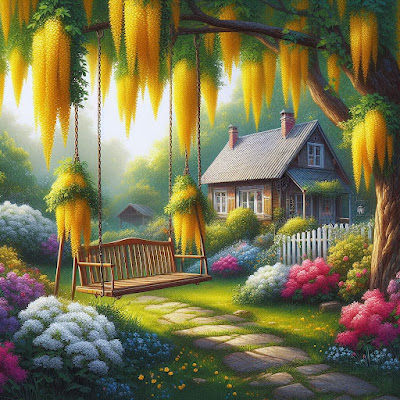A Day - Emily Dickinson | I'll Tell You How the Sun Rose | BOSEM Class 10 English Literature Reader
Board of Secondary Education Manipur (BOSEM)
Class 10
English Literature Reader (Poetry)
Chapter - 7
A Day
Substance/Summary of the Poem
Stanza-wise Analysis of the Poem
I’ll tell you how the Sun rose –A Ribbon at a time –The Steeples swam in Amethyst –The news, like Squirrels, ran –
The Hills untied their Bonnets –The Bobolinks – begun –Then I said softly to myself –‘That must have been the Sun!’
But how he set – I know not –There seemed a purple stileWhich little Yellow boys and girlsWere climbing all the while –
Till when they reached the other side,A Dominie in Gray –Put gently up the evening Bars –And led the flock away –
In the final stanza of ‘A Day‘, Emily Dickinson’s faith is revealed. This stanza is rich in symbolism, using Christian references such as “flock” and “Dominie in gray” to express the poet’s perspective on death. In this context, a “Dominie in gray” represents “God”, while “flock” symbolises human beings. Dickinson believes that God guides human beings after death.
At the same time, the stanza also signifies the onset of evening as the sun sets. The lack of activity during this time contributes to the speaker's lack of excitement at this point. Therefore, ‘A Day‘ concludes on a sombre note, reflecting the subdued emotions of the speaker.
Solved Textual Exercises
I. Answer the following questions in a sentence each.1. What looks like a ribbon?
Ans.: - In the morning, the radiant sunlight resembles a flowing ribbon.
2. "The news like squirrels ran." What is the news about?
Ans.: - The news is that the sun has risen, and its rays are illuminating the entire planet.
3. What are the hills compared with?
Ans.: - When the sunlight appears, the hills stand out like individuals wearing bonnets.
4. What do the bobolinks do?
Ans.: - When the sunlight appears, the hills stand out like individuals wearing bonnets.
5. Does the poet know about the sunset?
Ans.: - No, the poet doesn't know about the sunset.
6. What does 'a dominie in grey' symbolise?
Ans.: - The phrase 'A dominie in grey' represents the idea of mourning when death is imminent.
II. Answer the following questions briefly.
1. "I'll tell you how the sun rose." Why does the poet say so?
Ans.: - The poet expresses this sentiment because she is confident about how the day will progress once the sun starts to rise. Symbolically, the poet intends to convey that birth is akin to the start of life, a wondrous miracle similar to the rising sun.
2. How do the steeples swim in amethyst?
Ans.: - The entire atmosphere gradually transforms from darkness to light, and the sky adopts the hue of amethyst. The steeple, the tall pointed tower of churches, appears to be floating in the deep blue sky.
3. "The news like squirrels ran." Explain the imagery.
Ans.: - When the sun ascends, its rays spread swiftly in all directions. Every element of nature responds to the emergence of the sun. The sight of a sprinting squirrel symbolises the rapid pace that we must confront at the beginning of each day.
4. How do the hills unite their bonnets?
Ans.: - The poet portrayed the hills as graceful maidens. As the sun rises, the mist starts to dissipate, creating the image of maidens delicately removing their bonnets to fully display their beauty.
5. Why do the bobolinks begin to sing?
Ans.: - The emergence of the sun marks the arrival of a fresh day, symbolising new opportunities. Consequently, the bobolinks commence their melodious chirping, expressing their excitement for the upcoming day.
6. 'But how he set, I know not." Why does the poet say so?
Ans.: - When the sun sets, the earth is engulfed in darkness, symbolizing the reality of death. This line signifies the mysterious nature of death, the enigmatic counterpart of life, about which the poet expresses her lack of understanding.
7. What things are reminded to the poet, when she sees the sky during sunset?
Ans.: - Upon witnessing the evening sky, the poet visualises a stile, with the clouds resembling a drawing of children ascending it. Additionally, she imagines a figure closing the gate and shepherding the children to the opposite side. This portrayal evokes a sense of tender and reassuring comfort regarding death, conveying the idea that God will embrace us in the afterlife.
8. "A dominie in grey." What does this image mean?
Ans.: - The gentle, caring presence of the dominie could be compared to the image of God, providing comfort and affection. The dominie's grey robe may symbolise mourning, while their guidance of the children could be seen as a representation of God's acceptance of us into his realm upon our passing, conveying the idea of being secure under God's protection.
And led the flock away."
Explain.
Ans.: - When the sun sets, the calming act of closing the evening bars by the innkeeper offers a sense of peace. Likewise, a shepherd guiding his flock of sheep home at the end of the day evokes a similar feeling. In a similar manner, it is believed that God will welcome us into his realm when our life comes to an end.





Comments
Post a Comment